|
|
|
Sort Order |
|
|
|
Items / Page
|
|
|
|
|
|
|
| Srl | Item |
| 1 |
ID:
146595
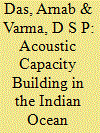

|
|
|
|
|
| Contents |
The fractured maritime mandate in India and the involvement of multiple agencies and ministries for matters maritime, make it complicated to achieve synergy. The UWR, Goa is a defence facility under the Ministry of Defence, the Ministry of Earth Science in mandated to provide R&D support for ocean related aspects, the we have the Ministry of Shipping and Ministry of Science and Technology as other players. It is known that there are close to 17 agencies and ministries of the Government of India involved in maritime issues. The huge resource and support required for UDA is possible only when all these agencies come together for a long term commitment to enhance our UDA in the IOR. A comprehensive Maritime Strategy formulation with clear focus on UDA is the only way forward to synergise the efforts of all the possible players involved. The Make in India initiative can be leveraged to contribute significantly to the Blue Economy with a clear maritime focus backed with an effective Maritime Strategy translating to enhanced Acoustic Capability in the future.
|
|
|
|
|
|
|
|
|
|
|
|
|
|
|
|
| 2 |
ID:
146562
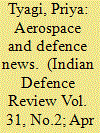

|
|
|
| 3 |
ID:
146594
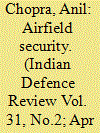

|
|
|
|
|
| Contents |
A typical IAF base is secured during peacetime by DSC personnel manning the peripheral watch towers and the important operational assets augmented with air-warrior guards comprising non-technical staff who are not engaged in active operational activities. DSC numbers need serious augmenting and forward bases should have a relatively younger lot. The limited Garud Commandos act as Quick-Reaction Force and take on larger real-time threats. While the Garud are better armed and better trained, they have other tasks and roles such as Suppression of Enemy Air Defence (SEAD) through Radar-bursting, and Combat Search and Rescue (CSAR). Garud units need to be increased to two from present one in forward bases.
|
|
|
|
|
|
|
|
|
|
|
|
|
|
|
|
| 4 |
ID:
146586
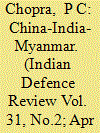

|
|
|
|
|
| Contents |
The large porous and underdeveloped border could also be turned into a border of peace and progress. The pro-democracy movement and Myanmar’s integration with Western economies, would give a much needed push towards studying Western concepts and learning English. As such, India needs to open, near the Indo-Myanmar border, a large number of schools, colleges and a university specialising in teaching English and democratic concepts and shared cultures. Students with special passes should be able to just walk over and attend classes in India. The area is especially suited for Myanmar’s citizens near and around the capital Naypyidaw in Northern Myanmar, where the need is greatest. This matter needs to be pursued with the present government on priority. This would enhance India’s soft power status as also protect her interests.
|
|
|
|
|
|
|
|
|
|
|
|
|
|
|
|
| 5 |
ID:
146631
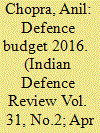

|
|
|
|
|
| Contents |
March 2016 was an eventful month for the Indian Air Force (IAF) on many counts. The Indian defence forces were still recovering from the lower than expected increase in the defence allocation in Budget 2016-2017. In fact, the Finance Minister for the first time did not even mention the allocation for defence in his speech in the Parliament. With dithering modernisation, the capital fund allotments were considered rather meagre. The IAF’s Exercise Iron-Fist 2016 on March 18 was the largest ever show of air power. In spite a great event, there were a few clearly visible weapons misses that were critically talked about.
|
|
|
|
|
|
|
|
|
|
|
|
|
|
|
|
| 6 |
ID:
146619
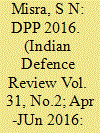

|
|
|
|
|
| Contents |
The Kargil Conflict had fortuitously brought to the centre-stage the need for an integrated approach towards intelligence gathering and joint operations. The 26//11 Mumbai attack has woken us to the reality of a unified approach between the states, the Coast Guard and the Indian Navy. The Defence Procurement Procedures over the years have tried to bring transparency into our procurement process and there have been some moves towards increasing private sector participation in defence manufacturing. However, unlike automotives and telecom sector, the relationship between the DPSUs, the DRDO and the private sector remain uneasy and adversarial. The DPSUs still do not consider the private sector as partners but as contractors.The record of private sector players such as L&T in strategic programmes like that of Arihant is salutary. A defence capability improvement would need major structural change.Either we have a DGA-like structure or the COCO structure of the USA with the government providing oversight on strategic issues.
|
|
|
|
|
|
|
|
|
|
|
|
|
|
|
|
| 7 |
ID:
146574
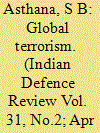

|
|
|
|
|
| Contents |
To flourish a terrorist outfit needs financial and logistics support, political patronage and a
supportive of submissive population, which is the centre of gravity in prospering or combating
terrorism (providing recruitment, intelligence, misguided ideology/religious narrative, media and cyber/technological support). To combat such dangerous terrorist outfits and save innocent population, it is of utmost importance to cut down its support system, its patronage and assistance, sincerely and honestly by every single legitimate power in the world, selective degrading of some organisations such as the ISIS with minimum callateral damages and take onboard some religious leaders, who can support the narrative of peaceful eoexistence for all communities.
|
|
|
|
|
|
|
|
|
|
|
|
|
|
|
|
| 8 |
ID:
146573
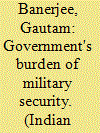

|
|
|
|
|
| Contents |
It needs no revelation that there is widespread consternation within the strategically committed community, the intelligentsia and the media over the growing obsolescence and declining operational capability of the ultimate cutting instrument of national power - the military force structure. Thus in spite of maintaining the third largest military force in the world, there is imposition of only a fractional deterrence upon the perennial adversaries while they keep jabbing hurtfully at rib of the Indian nationhood. The new political leadership is apparently intent on remedying that undesirable situation. Therefore, to turn its rhetoric into action, the NDA government has to acknowledge that there are two distinct aspects to the amelioration of that undesirable stage, and tackled these on priority if its political pronouncements are to gain respectability from the citizenry.
|
|
|
|
|
|
|
|
|
|
|
|
|
|
|
|
| 9 |
ID:
146563
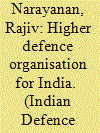

|
|
|
|
|
| Contents |
The restructuring of both the MOD and the service HQs, with the relevant changes in the AOB/TOB rules and the creation of the CDS/PCSOC is the need of the hour, if India is to be an effective major power amongst the comity of nations, An integrated MoD will eliminate existing infirmities and result in higher levels of synergy, efficiency and decision making ability.
|
|
|
|
|
|
|
|
|
|
|
|
|
|
|
|
| 10 |
ID:
146585
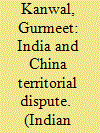

|
|
|
|
|
| Contents |
China's negotiating strategy on the territorial dispute is to stall resolution of the dispute till it is in
a much stronger position in terms of comprehensive national strength so that it can then dictate
term. The rapidly blossoming strategic partnership between China and Pakistan is also a major cause for concern. During any future conflict with either China or Pakistan - even though the probability is low, India will have to conted with a two- front situation as each is likely to collude military with the other - a situation for which the Indian armed forces are as yet unprepared. Hence, it is in India's interest to strive for the early resolutiion of the territorial dispute with China so that India has only one major military adversary to conted with.
|
|
|
|
|
|
|
|
|
|
|
|
|
|
|
|
| 11 |
ID:
146560


|
|
|
| 12 |
ID:
146564


|
|
|
|
|
| Contents |
In hostile interactions between nations, there are no rules for the victors till the status quo has been established. India is a continental country and should, therefore, have a realistic outlook
and possess strong land forces, unlike other nations which maintain strong navies and have
sea barriers to protect them. Wars, if fought, should have decisive outcomes so as to ensure a
century of peace thereafter, goes the old Clausewitzian dictum, The importance of restructuring
Indian army's battle groupings to fight decisive deep operations in order to permanently achieve the strategic upper hand should, therefore, not be lost sight of. Our national war aim should not be the capture of territories or assimilation of hostile populations but to ensure the destruction of enemhy forces, and a favourable outcome to neighbourly relations in the decades ahead. In the wars fought by India since independence, this reality has been significantly lacking in decision making inputs.
|
|
|
|
|
|
|
|
|
|
|
|
|
|
|
|
| 13 |
ID:
146581
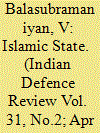

|
|
|
|
|
| Contents |
Competition among fundamentalist groups could push each of them to outdo others who would evolve in a constant state of ‘one-upmanship’. There are already strong indications of such a threat emerging in India. Incidentally, the Al Qaeda’s first cell in the Indian subcontinent was recently uncovered in Sambhal. Given this discovery, the Islamic State’s growth in India will lead to competition among like-minded groups such as Al Qaeda in the Indian subcontinent, which would spur them on to unleash more violence in different parts of India. Constituted by a literate membership, driven by hardcore ideology, the Islamic State in India has essentially become a new brand of terrorism which is as yet unseen in the annals of political violence.
|
|
|
|
|
|
|
|
|
|
|
|
|
|
|
|
| 14 |
ID:
146587


|
|
|
|
|
| Contents |
The Chinese have aggressively involved themselves in Myanmar yet they are unsure of their future relationship and their investments due to the oncoming democratically elected government. Chinese involvement in Myanmar has been viewed with a great deal of hostility by the locals, as they perceive that the Chinese have exploited their country through corrupt deals and benefitted themselves more than anyone in Myanmar. Consequently, Chinese investment fell from $12 billion in 2008- 2011 to just $407 million in 2012-2013. This resentment has forced the current government to renegotiate most of their major projects to get better terms for themselves. China is also wary of the NLD leader's proximity to the West (US) and its allies like Japan and South Korea. Thus China would have to fight tooth and nail to retain her influence in Myanmar and Safeguard her national interest.
|
|
|
|
|
|
|
|
|
|
|
|
|
|
|
|
| 15 |
ID:
146602
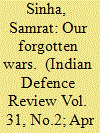

|
|
|
|
|
| Contents |
The humanitarian emergency which occurred in the aftermath of the 2012 violence between
Bodos and Bengali muslims (in which more than 1000 people were killed) was a crisis of immense magnitude and stretched the existing reponse mechanisms. According to the data provided by the Assam State Disaster Management Authority (ASDMA), the peak of the crisis witnessed 485,921 persons displaced (in September 2012) with 246,582 persons residing in formal relief camps. The duration of the emergency can be gauged by the fact that as of January 31, 2013, there were still 38,959 persons still residing in formal camps. These camps were ethnically segregated with Bodos and muslims residing separately.
|
|
|
|
|
|
|
|
|
|
|
|
|
|
|
|
| 16 |
ID:
146632
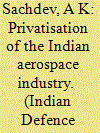

|
|
|
|
|
| Contents |
Make in India” has been around for some time now, both as a slogan and as a rallying point for industrial lobbies. As far as the aerospace industry is concerned, the single major act of faith the government can perform is to level the playing field for private players. The only way that can be done is to permit fair competition between PSEs and private industries so that their individual strengths are pitted against each other in ‘May the best man win!’ gladiatorial, free market arenas. The private sector has amply demonstrated its capability and willingness to aoutdo public sector achievments. All it needs is a chance to do so.
|
|
|
|
|
|
|
|
|
|
|
|
|
|
|
|
| 17 |
ID:
146618
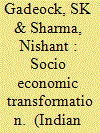

|
|
|
|
|
| Contents |
Ex-servicemen are role models of ethical leadership with ingrained morals and value systems focused on duty, honour and country, contributing to society and nation building in substantial proportion with a great sense of commitment towards multi-faceted progression and excellence in all spheres of activities. Perhaps the first step in this direction is to identify the cardinal segment of the rural economy, which has so far not attracted adequate attraction of the policymakers but which deserves focus in the new government strategy.
|
|
|
|
|
|
|
|
|
|
|
|
|
|
|
|
| 18 |
ID:
146561
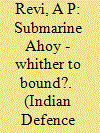

|
|
|
|
|
| Contents |
The MOD's 1997 proposal for a 30-year s/m building programme got CCS endorsement only
in 1999. It consisted of a long term plan for indigenous construction of twenty-four s/m over a period of thirty years. In 2002, Admiral Madhvender the incumbent CNS, is reported to have commended the recent decision of the government to go ahead with the 30 year s/m building plan. He further added that during the first ten years there will be licensed manufacture of s/m. Subsequently, it will be completely indigenous presumably meaning, indigenous design and production.
|
|
|
|
|
|
|
|
|
|
|
|
|
|
|
|
| 19 |
ID:
146576
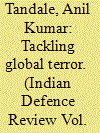

|
|
|
|
|
| Contents |
The states which are nurturing and nursing terrorists must be held responsible for the conduct of non-state actors because they operate from within the territorial boundaries of the host country. Every state is bound to respect the sovereignty of other countries, and hence these states cannot avoid its liability by any excuses. India’s vital interests can be better served by invoking the expanded doctrine of offensive self-defence, which has witnessed a normative evolution, particularly in relation to non-state actor, following the events of September 11, 2001. This expanded doctrine, has also gained acceptance of the Western power and scholars which permit the victim states to use force against non-state actors and breach the territorial sovereignty of foreign states in response to an accumulation of terrorist attacks.
|
|
|
|
|
|
|
|
|
|
|
|
|
|
|
|
| 20 |
ID:
146596


|
|
|
|
|
| Contents |
The North East is located at a crossroads between three major economies – East Asia, South Asia and Southeast Asia. This geopolitical advantage, has however, not really translated into the region’s economic development. Despite the high growth in India’s trade ties with Southeast Asia and China in the recent past, the region’s role has been marginal in terms of its contribution to trade and as a trade route. The NE region has not been able to integrate and benefit from the various regional and sub-regional initiatives that neighbouring countries have created.
|
|
|
|
|
|
|
|
|
|
|
|
|
|
|
|
|
|
|
|
|